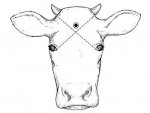Not really sure where to post this, but this seems like as good of a place as any of the others. A friend has asked me to load him some ammo for the purpose of dispatching sick cattle. He raises beef cattle on a small farm and has periodically had to dispatch a sick or injured animal. In the past he has shot animals with a .44 mag that belonged to an employee of his, but that is no longer available. I told him that a .223 would be marginal at very best and he should really look for something a little more potent but he is still willing to use what he has. Any input would be appreciated, experience especially would be valued. Any suggestions for bullet, would be helpful. His preferred method is one round to the base of the skull, but the bone density there seems like it may be tough to smash with a .223, so shot placement suggestions would be helpful too. I currently have 75 hunting VLD's, 77 SMK's, 80 Nosler CC's and 60 partitions, so I would prefer to use one of those if possible.
Thanks
JS
Thanks
JS


